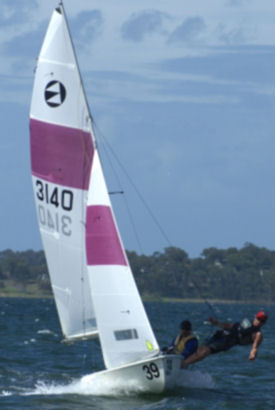 | |
Jamie Thomson's Rig Concept
-
The starting point of my thinking is that the boat is generally underpowered... hence, you need to keep the mast pretty straight and the boat powered up.
The mast is a relatively soft section, so the battle is to keep it from bending too much, compressing between the hounds and base and losing forestay tension. The new thicker walled James Glass masts are noticeably stiffer.
Now you have to think about keeping mainsail leech tension..by vang or mainsheet..
If you use vang and end-boom sheeting the mast will bend a lot low down..especially just when you are trying to carry maximum leech tension, i.e, when you are fully hiked, crew on wire and not yet easing the sheets.
To combat this you could use an internal stiffener and / or lower spreaders.
Lower spreaders save weight but then you lose some control on the upper section of the mast.
Stiffeners add weight where you don't want it..far from the centre of gravity of the boat. It's similar to sailing with half a kilo right on the bow. Would you want to sail like that?? in a chop??
So...I didn't want a stiffener, and want to control as much of the mast as possible with the spreaders (as high as allowed, which is close to half way up the mast), but still get adequate mainsail leech tension.
Solution: use a central boom traveller along the thwart.
I sail by setting the mainsail leech tension with the mainsheet cleated off to the centre case behind the thwart, then play the traveller (it's usually sheeted to windward).
I have perfect control over leech tension, and control power by playing the traveller in and out for the gusts/lulls.
I only ever use the vang if it's blowing REALLY hard, and downwind.
My rig is noticeably light if you pick it up.
Gybing is also a cinch with centre-sheeting.
Tacking is easy with regard to the tiller extension.
Drawbacks are learning to tack efficiently, particularly picking up the new windward side of the traveller, and making sure the main stays cleated while playing the traveller. Yyou just have to be careful not to flick it out of the cleat accidentally. It could be said to be more expensive, but I save on the stiffener, plus labour, and extra purchases/pulleys for the vang and cleats. I only have a simple 4:1 cleated with a simple jamb pulley..cheap as.
As a general guide, I recommend that from the upper black band on the mast to the point where transom meets the floor of the hull, should measure 6140mm. This is a good starting point, but may vary in relation to mast step position, sail shape, and variations in hull shape.

| National 125 Association | admin | |